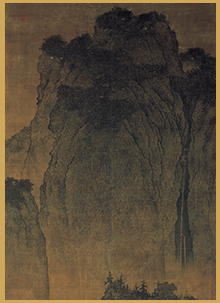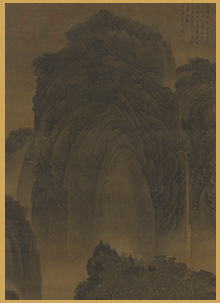Travelers Among Mountains and Streams
Fan Kuan (ca. 950-ca. 1031), Song dynasty
Fan Kuan (style name Zhongli), a native of Huayuan (modern Yaoxian, Shaanxi), excelled at landscape painting and early studied the styles of Li Cheng (916-967) and Jing Hao (fl. first half of the 10th c.). Later, after years of observing Nature, he was able to form a style of his own.
This painting employs a tripartite composition and features a rocky promontory centered in the foreground with a donkey caravan below and lofty peaks in the background rising to form a range of monumental mountains. The base of the mountains is left blank to indicate enveloping mists while also to highlight the effect of distance and separation. The forms throughout the work are rendered with angular outlines in ink, the texturing within the landscape elements done in short strokes similar to raindrops, thereby simulating the geological characteristics of rocks and mountains there. The monumental range looms over the tiny figures in the caravan, creating a dramatic contrast that expresses an awe-inspiring appreciation of the majestic forces in Nature. In the lower right area, hidden among the trees, is the signature for “Fan Kuan.”




